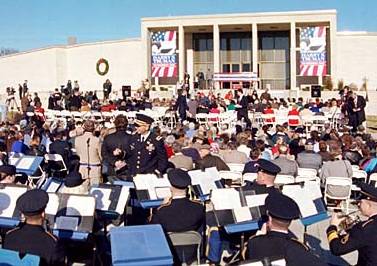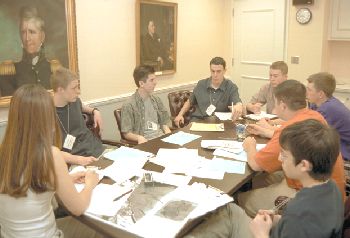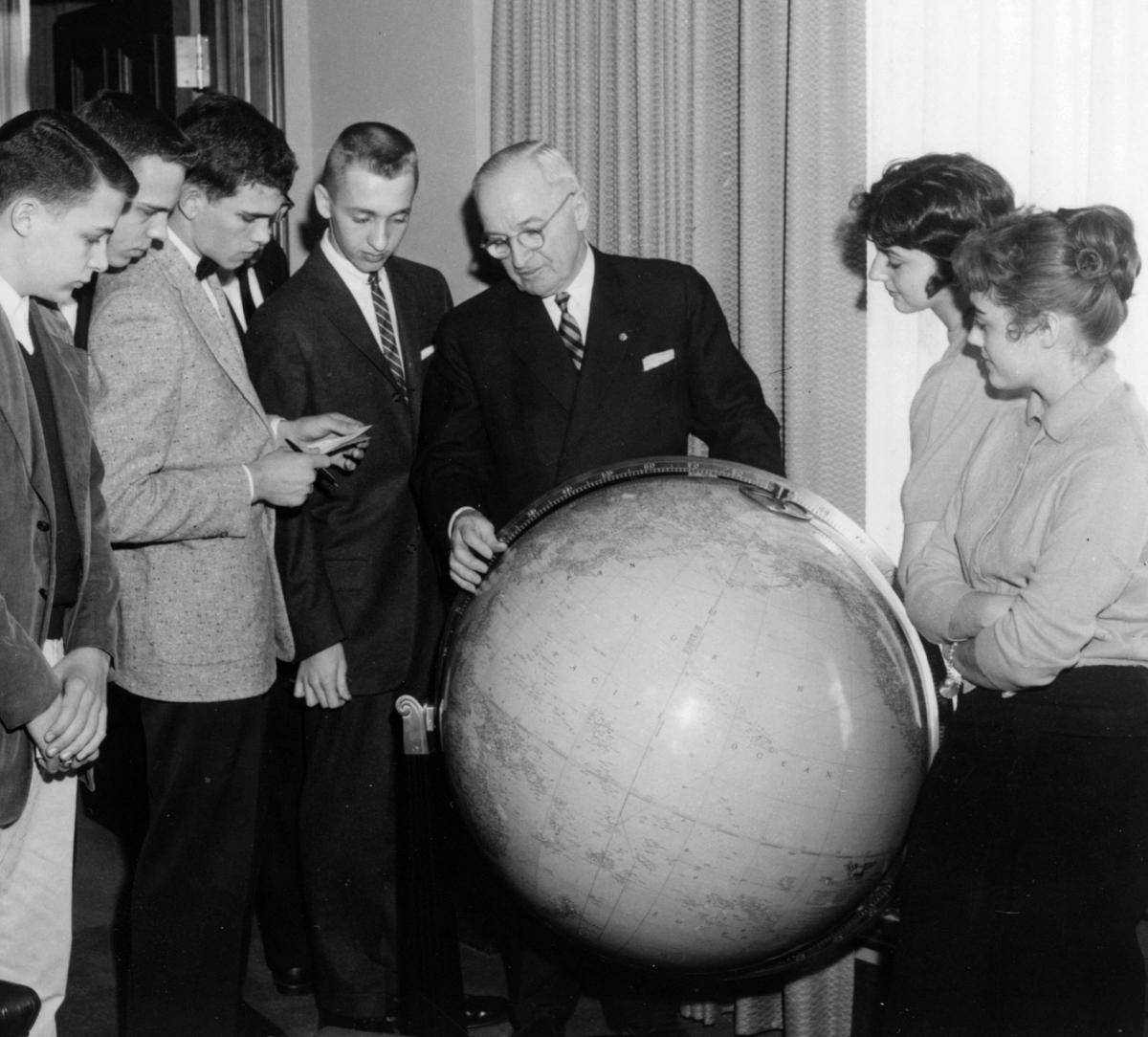
Updating Harry Truman's Library
Interactive Features Enliven New Exhibits after Extensive Renovation
Spring 2002, Vol. 34, No. 1 | Spotlight on NARA
When the Harry S. Truman Library and Museum in Independence, Missouri, opened in 1957, one of its most popular attractions was Harry S. Truman himself.
The former President, whose home was just down the street, spent a lot of time at his library in the late 1950s and 1960s nurturing his library—greeting visitors, leading tours, meeting with student groups, receiving important guests, or tending to daily business in his office. He even started the volunteers program, which now numbers 118. And it is said that if you called the library early enough in the morning, Truman himself, a noted early bird, might answer the phone.
Today, the Truman Library does not have the nation's thirty-third President. However, it can point with pride to the results of a $22.5-million renovation that not only has provided much-needed structural repairs and upgrades to the building but also expands the library's exhibit and educational space and breaks new ground in its efforts to make Truman and his times come alive for new generations of Americans.
New components to the library provide technology-rich, interactive exhibits highlighting the Truman presidency and an experienced-based program in which high school students learn how decisions were made in the Truman White House. Another exhibit, detailing Truman's life before and after his years as President, will open in 2003.
"These new features at the library help us do a much better job of recreating the Truman presidency for generations who are unfamiliar with it and to show how many of the important decisions President Truman made still guide our nation today," said Michael Devine, director of the library.
As the nation's second-oldest presidential library, the Truman Library has been for years a destination for millions of tourists, history buffs, students, and others who wanted to find out more about one of the most colorful and popular Presidents of the modern era.
After assuming the presidency in 1945 upon Franklin Roosevelt's death, Truman was elected in his own right in 1948 and served until 1953, when he retired to Independence. He died in 1972.
A Rededication
With most of the renovation completed, the Truman Library was re-dedicated December 9, 2001. At the ceremonies, David McCullough, author of the Pulitzer Prize–winning biography Truman, noted how Truman's rise to power and greatness often puzzled people. "People called him a simple, little man from Missouri," McCullough said. "But he wasn't simple and he wasn't little. Giants come in all sizes."
Truman's eldest grandson, Clifton Truman Daniel, also spoke, noting that his grandfather had spent a lot of time in developing the library in its early years. Now, he said, it is time to bring Truman's story to a twenty-first-century audience. "There are a whole bunch of young people and new immigrants who haven't heard of him," he said.
The rededication also featured remarks by Devine; Thomas McDonnell, chairman of the Truman Library's private, nonprofit support organization, the Truman Library Institute; and Robert Holden, governor of Missouri.
The eighteen-month renovation project at the library, which opened in 1957, is the most extensive renovation to date of any of the nation's ten presidential libraries, which are administered by the National Archives and Records Administration.
Perhaps the most innovative of the new features in the library is a White House Decision Center, located in a former storage area that is now the Ed and Beth Smith Education Wing. This area is modeled after the West Wing of the White House, where the President's Oval Office is located, where his top assistants have offices, and where the White House press room is located.
The White House Decision Center, which opened in October 2001, is a first-of-its-kind experiential program for high school students to learn, through study and role-playing, how some of the historic decisions that came out of the Truman presidency were made.
This school year, it is expected that some two thousand secondary students from middle and western Missouri and eastern Kansas will have participated in the program. For the first full year next year, it is expected that six thousand or more students will participate. For the day-long exercise, students come in groups of thirty to seventy. Before coming, they spend time at their own school studying decision-making. Once they arrive, the groups receive their assignment in the form of an issue that Truman faced: the Berlin blockade or Truman's order to desegregate the armed forces, both of which occurred in 1948, or the start of the Korean war in 1950.
At the Decision Center, the students are broken into as many as eight groups, and each member of a group is assigned a role: President, secretary of state, secretary of defense, press secretary and so forth. During the day, they discuss the assigned issue that Truman faced and come to a decision. As a culminating event, all of the students except those playing the role of President become reporters in a mock press room. The "Presidents" meet, come to a decision, and select one of their group to give a press conference. The students' deliberations are supervised by Truman Library Institute staff and their own teachers.
The program was developed by the Truman Library Institute with assistance from The Learning Exchange, a Kansas City - based educational consulting group. The program meets national and state social studies standards.
"In this program, students are practicing history the way they would practice chemistry or physics in the science lab," said Tom Heuertz, associate education coordinator of the institute and director of the White House Decision Center.
Richard Claypoole, NARA's assistant archivist for presidential libraries, noted that the Decision Center goes beyond traditional education programs that presidential libraries have pursued in the past, which largely have been linked to their own exhibits and programs.
"The Truman Library is the first library to conceive and implement an education classroom program and build an exhibit around a classroom experience designed to meet educational standards," said Claypoole. "This truly first-rate interactive experience provides students with historical insights into the life and legacy of Harry Truman, but even more importantly, teaches them how to think critically and make informed decisions on important issues."
Truman's Presidential Years
Also new and open to the public is a multimedia, interactive exhibit on the upper floor of the library's east wing called "Harry S. Truman: The Presidential Years."
The exhibit opens with a thirteen-minute orientation film tracing the story of Truman and his family up to April 12, 1945, when Vice President Truman succeeded to the presidency upon Roosevelt's death. The film was produced and directed by the Academy Award–winning filmmaker Charles Guggenheim. It is narrated by Jason Robards.
After seeing the film, the visitor proceeds to an exhibit made up of audiovisual components, artifacts, still photographs, and interactive activities that describe not only the milestones of the Truman presidency but what life in America was like during the Truman era of the late 1940s and early 1950s.
This exhibit includes two "Decision Theaters." One of them focuses on Truman's recognition of the state of Israel and his order to desegregate the armed forces, both in the context of the 1948 election campaign. Visitors are asked to indicate (on keypads) what they think most influenced Truman in making his decisions on these two issues. Later on in the exhibit, a second "Decision Theater" focuses on Truman's decision to establish a federal loyalty program in 1947. Visitors are seated in a room similar to a congressional hearing room or interrogation room and asked questions regarding the proper balance between national security concerns and personal private/free speech. Visitors are then asked (again, on keypads) to register their opinions.
Both "Decision Theaters" conclude by asking the viewer to consider and register their opinions on strikingly contemporary issues facing presidential decision makers. For the first "Decision Theater," the question is whether to authorize women in combat in the military. The second "Decision Theater" poses the civil liberties question of governmental monitoring of personal email as part of the efforts to stop spies and terrorists.
This exhibit also features displays that highlight the milestone events in the Truman presidency: the first four months, which included the decision to drop the atomic bomb and the end of World War II; postwar America; the beginning of the Cold War; Truman's surprise 1948 election victory; and the Korean War. It also has a display of some of the artifacts of American life in the early 1950s, such as early televisions and kitchen appliances. Another element examines Truman's last months in office and his legacy.
The visitor ends his tour of this exhibit in the Legacy Gallery, which houses a new life-size statute of Truman that overlooks the courtyard and the gravesites of Harry and Bess Truman.
In 2003 another exhibit, "The Life and Times of Harry S. Truman," which will trace Truman's life before and after his terms in the White House, will open. It will consist mainly of artifacts from the Truman family and the different eras of Truman's life.
Funding the Renovation
The renovations to the Truman Library are being made possible by $16.5 million in funds raised by the Truman Library Institute, including $2 million from the State of Missouri, and an additional $8 million from the federal government through NARA.
The institute funded an addition that contains the Legacy Gallery on the upper level and parts of the Decision Center on the lower level as well as the already opened "Harry S. Truman: The Presidential Years" and the forthcoming "The Life and Times of Harry S. Truman." Federal funds were used for various physical renovations and additions, including preparing space for new exhibit galleries and the Decision Center, upgrading the lobby, building a new video theater, expanding the gift shop, modernizing the auditorium, and expanding public meeting rooms in the east wing.
Truman wanted his library to "give young people a better understanding of the history and nature of the Presidency and the Government of the United States." Today, with new interactive and experiential exhibits and programs, the Truman Library is staying on the course set by the thirty-third President himself.
For more information about the Truman Library and its new and continuing programs, go to www.trumanlibrary.org on the World Wide Web. The library is located at 500 West Highway 24, Independence, MO, 64050-1798; telephone 816-833-1400.



